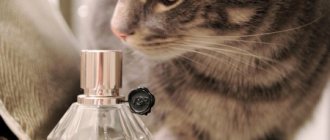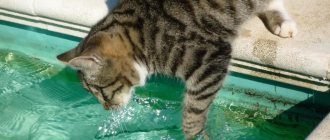In what range do cats hear?
The hearing range in which a cat can hear ranges up to 65 kHz, but in humans it is much smaller - only 20 kHz. A cat can perfectly distinguish noise in the ultrasonic range.
Interesting materials:
How to use Glitter on glass? How to use Google Authenticator on two devices? How to use egg cells in the garden? How to use Yandex disk? How to use perspective correction? How to use nori sheet? How to use mozzarella on pizza? How to use fireball in Dark Souls? How to use carrion? How to use papillottes?
Are cats afraid of cucumbers? How to properly scare a cat and is it worth it?
The whole world is going crazy over videos of cats that, for some reason, jump away in horror from ordinary cucumbers. Medialeaks decided to understand this strange phenomenon and answer all the questions that arise.
Come on. Are they really afraid?
Seems to be yes. Videos about the incredible horror that cucumbers suddenly appearing on the floor cause in cats have been appearing online for a long time, but this topic has gained popularity thanks to several collections of similar videos.
It usually looks like this: an unsuspecting cat eats from his bowl, turns around and jumps away in horror from the vegetable lying on the floor, striking a funny pose. With some cats this can be done more than once.
Accompanied by cheerful music, such collections collect millions of views.
How it works?
Comments from scientists and veterinarians on this topic are worthy of Captain Obvious, but we will quote them anyway. The thing is that cats are frightened by objects that suddenly appear on the floor in close proximity - they would prefer to get to know it at some distance. Your pet probably doesn't care at all whether it's a cucumber or something else.
“I think this is a reaction to the sudden discovery of an unusual object, secretly placed while they are busy with the bowl. Cats are suspicious of the unknown: it could be a snake or other predator. I suspect a toy spider, a plastic fish or a mask with a human face would produce the same reaction,” says animal behaviorist Roger Mugford.
It’s worth adding here that experts do not recommend scaring cats. Nothing bad will happen to him, of course, but you can ruin his psyche, and therefore the relationship with his pet, say experts interviewed by National Geographic.
“If you cause stress to an animal, that's probably not a good thing. If you're doing this for laughs, I have questions about your humanity,” urges California veterinarian Jill Goldman.
Think Like a Cat author Pam Johnson-Bennett explains that cats consider the bowl area to be the safest area in the house, so the appearance of an unexpected object in it frightens them so much that they try to escape in any way possible. "It's cruel," she says. John Bradshaw of the University of Bristol, who wrote the book Cat Feelings, said such human behavior was “contemptible.” Think about it.
But Reddit users who discussed this topic were skeptical about the experts’ comments.
“Life for domestic cats is really tough. Sleep, eat, sleep, put in the tray, sleep. To be ********, to sleep"
“My cat scares me, gets in my legs, pees on things, makes me wake up at 3 in the morning to open the door. Somehow I don't see an article written for cats about how painful these things can be for humans. Bastards"
“My cat sits all day in an air-conditioned room, can scratch whatever he wants, eats what I put in a bowl, drinks, sleeps and has absolutely everything. I think he will survive the jump from being scared of the cucumber. If not, he's an even bigger ******* than I thought."
“This was the funniest thing I've ever done with my cat. Over the course of a month, I collected sticker cards and covered my apartment floor with them, sticky side up. I mean THE ENTIRE FLOOR. It took hours. Thousands of little sticky squares. The cat was watching me from the sofa. He wanted to play with the rubber lizard. I threw it across the room. He got halfway there before he realized the stickers were on his paws. The cat rolled over on his back to remove them, and the stickers stuck to his back. I will always smile when I remember him walking into the bedroom with a look of disgust. Boredom in the pre-internet era was a terrible thing. I still miss this cat."
My cat is not afraid of cucumbers. This is fine?
And that's okay too. Inspired by such videos, people around the world began to try to scare their pets. Some didn't succeed.
The Komsomolskaya Pravda staff had an interesting evening and concluded that Russian cats are fearless.
“We dedicated yesterday evening to our own experiment. All Komsomolskaya Pravda employees who have cats brought home large cucumbers. When the cat was eating, they placed a cucumber behind his back and grabbed the camera or phone.
The cats reacted calmly. No one got scared, didn’t recoil, didn’t hiss, didn’t fly away, didn’t run away, it was even offensive! Our cats are desperate, brave and indifferent to cucumbers. Some sniffed, some nudged with their paws, some simply passed by without paying attention,” the publication writes.
After all, there are cats that really love cucumbers.
Bonus.
If, despite all the warnings, you want to scare your cat, but nothing worked with cucumber, here is a more effective remedy (be careful, it can also affect people).
Adapt your home for your cat
The best thing you can do for a scared cat? Do your best to make sure she doesn't get scared at all. If your cat is naturally nervous, establish a routine to help her feel calm and safe.
Fearful cats do best when things are predictable—the same person feeds and cleans for them at the same time every day, and their home range does not change regularly.
When you know there will be changes to your schedule or home, anticipate some anxiety and prepare a room with familiar items for him to unpack.
Naturally shy cats or not, most cats appreciate vertical space and shelter when stressful situations arise.
Frightened cats are looking for two things: a place to hide and a way to climb up. Being able to observe things from a higher perspective makes cats feel safe.
In such cases, buy a cat tree - one about 2 meters high, or special cat racks to provide plenty of safe space.
Determine if your cat is scared
Cats' behavior is notoriously difficult to read. But while every cat is an individual, they tend to exhibit characteristic behaviors when stressed.
“The fear response will manifest itself differently depending on the cat’s choice,” says Dr. Vyacheslav Kolokolnikov, a veterinarian and board member of the Russian Cat Society. “A scared cat will run away from a threat if possible. Otherwise, he may become more agitated and start biting and scratching.”
Pay attention to the following body language: dilated pupils, mustache raised almost horizontally, furrowed brow and concentrated gaze.
Frightened cat paws will be ready to either run away or defend themselves.
Be patient while your cat recovers
There's no telling how long it will take for your cat to feel safe, secure and ready to socialize after a stressful event.
Whether it was a loud noise, an overly friendly person, or a territorial feline that caused her to become scared, be patient and give her time to recover.
If your cat feels safe with you, you should sit alone and wait quietly. If you find yourself waiting longer than expected, don't be alarmed or try to rush the recovery process.
The cat will come to you on its own terms, which may not be yours. This could take hours or days - they play by a different set of rules.
Cat repeller: purpose and principle of operation
Cats are cute creatures until they begin to show their stubbornness and animalistic habits. This animal creates a lot of inconvenience when it enters an area where it is prohibited from entering. Repellers will help protect access. They do not injure the cat, but only irritate it, forcing it to quickly run away. The principle of operation of the devices is based on the emission of sounds, odors, unpleasant for the animal, sudden spraying or blinking. A repellent product is useful in the following cases:
- To protect beds and flower beds where cats like to go to the toilet or tear out and chew plants.
- To discourage homeless and neighborhood cats from entering your territory.
- To prevent your pet from entering rooms where he is not allowed to be (for example, a nursery or rooms with a computer, flowers, valuable antiques, etc.).
A cat repeller often becomes the only way to save flowers in an apartment or area from being torn out or eaten by curious cats.
Types of repellers
Water devices can be used to repel cats in your yard. They are not suitable for the home, as they wet not only the uninvited guest, but also furniture, carpets, walls, and appliances. Ultrasound can be used to drive away cats both indoors and outdoors. But aerosol repellers are not suitable for open spaces (the smell quickly “dissolves” in the air); sprays are best used to limit cats’ access to rooms.
Water repellers
Such devices are sprinklers (water sprinklers). But unlike garden devices that turn on regularly and are intended for watering lawns and beds, repellers begin to accurately emit jets of water when motion sensors are triggered.
An example of a water repeller is Scare Crow. The device costs from 4800 rubles. The range is up to 10 meters. The sensor detects movement and sends a signal to the sprinkler, which is connected to a hose with water. The jet under strong pressure, moving from side to side, frightens a cat that has wandered into someone else's territory and forces it to hide.
The battery used is a 9 V battery, which is designed for 1000 sensor activations
The repeller works not only on cats. A device like Scare Crow is effective against raccoons, foxes, stray dogs, crows and other animals and birds. As a rule, after 1-2 “wet” attacks, the guest remembers that an unpleasant water procedure awaits him here, and no longer makes attempts to get into someone else’s yard.
Ultrasonic repellers
These devices, when triggered by a motion sensor, begin to emit sound at a high frequency. The human ear does not perceive it, but animals hear it well, and it is unpleasant for them. Ultrasonic repellers are suitable for the interior of houses, apartments, and for protecting yards. They protect not only from cats and stray dogs, they are also effective against rodents - mice, rats, moles.
Grad Duos S is an American model suitable for repelling animals less than 5 kg. The device's two speakers generate ultrasound, which is not perceptible to humans. For the animal, the sounds produced are perceived as a sudden clap of thunder. The cat hears acoustic signals at a distance of up to 20 meters. The price of the device is from 2900 rubles.
The device weighs only 120 grams and can be mounted on a wall or an inclined surface - for example, a door slope or an external cornice.
Weitech WK0055 is another example of an ultrasonic repeller. Cats do not like sound emitted with a frequency below 20 kilohertz (humans cannot hear it). Also affects rodents, foxes, small dogs, pigeons, crows. The device scans the space at a distance of 16 meters and with a coverage angle of 90° - as soon as an animal enters the zone, a sound signal is immediately triggered. The device stops “screaming” only when the animal leaves the area covered by the sensor. The advantage of the repeller is that it does not work from the mains, but from batteries, so it can be placed in any part of the apartment, house, or yard. Weitech WK0055 price - from 3500 rub.
The device has a durable, water-permeable body that is not afraid of rain, snow, sunlight and dust
Aerosol repellers
Deodorizing spray works by emitting a liquid with an unpleasant odor for the cat. It can be manual (when a person needs to “aim” at the animal and press the dispenser or treat surfaces) and automatic (the sensor detects the movement, transmits a signal to the sprayer and it sprays the uninvited guest with an aerosol).
An example of a simple repellent aerosol is BioVax. They can be used to treat rooms or individual pieces of furniture, flowers, wires so that the cat does not approach them. The base is essential oils of orange, cinnamon and pepper. The smell is quite persistent (one spray lasts for 3-4 days), but it is strong only for the first 30-40 minutes, then it becomes barely noticeable to humans, but the cat will continue to feel it.
This aerosol repeller costs from 150 rubles
What smells are cats afraid of?
Cats have an excellent sense of smell. It is 14 times more acute than in humans, but not as strong as in dogs. With the help of smell, the cat navigates space, searches for a partner and its territory. A cat has its own world of smells, some of which the animal considers disgusting and is even afraid of.
Dirty tray
The cat does not like the smell of a dirty litter tray, which he himself went into. It should always be clean, so the owners must keep an eye on it so that they don’t find a “surprise” in the corner of the room or in a flower pot.
Eucalyptus and lavender
The smell of these plants causes rejection in cats. Therefore, if you want to protect your own garden or flowerbed from visiting animals, you should plant lavender. Cats perceive it as a toxic substance and will never set foot on the territory where it grows.
Spices
If a person smells like pepper, cinnamon or curry, then the cat will never approach him. Therefore, you should not be surprised if the animal avoids petting in every possible way and does not want to be stroked.
What can scare a cat?
Water
Cats are afraid of water, and this is due to the nature of their body structure. Animals have a dense and dense undercoat, which helps them retain heat. This is especially important for cats in winter and for those who live on the street. If the undercoat gets wet, thermoregulation is disrupted and the cat begins to freeze. He strives to quickly get out of the water and begin to dry his fur.
You can avoid such fear if you teach a kitten to use water, then an adult cat will not be at all afraid of getting wet and will enjoy bathing.
Aliens
Cats are sensitive to their place of residence; they perceive it as a personal kingdom. Therefore, all strangers are perceived as invaders who are trying to take this territory away from them.
Strangers have their own scent, so when cats hear it, they hide and, in an attempt to pet it, may bite or scratch it.
Sounds
Cats have very sensitive hearing. They need this in order to hear the subtlest sound of a mouse rustling in a hole. But if the sound is strong, it causes panic in the animal. Therefore, you should not be surprised if the cat hides at the sight of a vacuum cleaner, hair dryer or drill.
Other fears
Cats, like people, can be afraid of anything. For example, there are cats that cannot tolerate spiders. It has to do with nature. In ancient times, many mammals were smaller than spiders, so insects posed a threat to them. Much has changed since then, but the fear remains.
There is a version that cats are afraid of cucumbers, especially if you show them while the animal is eating. This fear is also associated with the nature of the origin of cats. Zoologists say that cats came from deserts where many snakes live. Cats associate cucumber with crawling creatures, so genetic memory is triggered.
There are cats that are afraid of heights. Don't be surprised if the animal starts screaming loudly once it's at the top of the tree.











